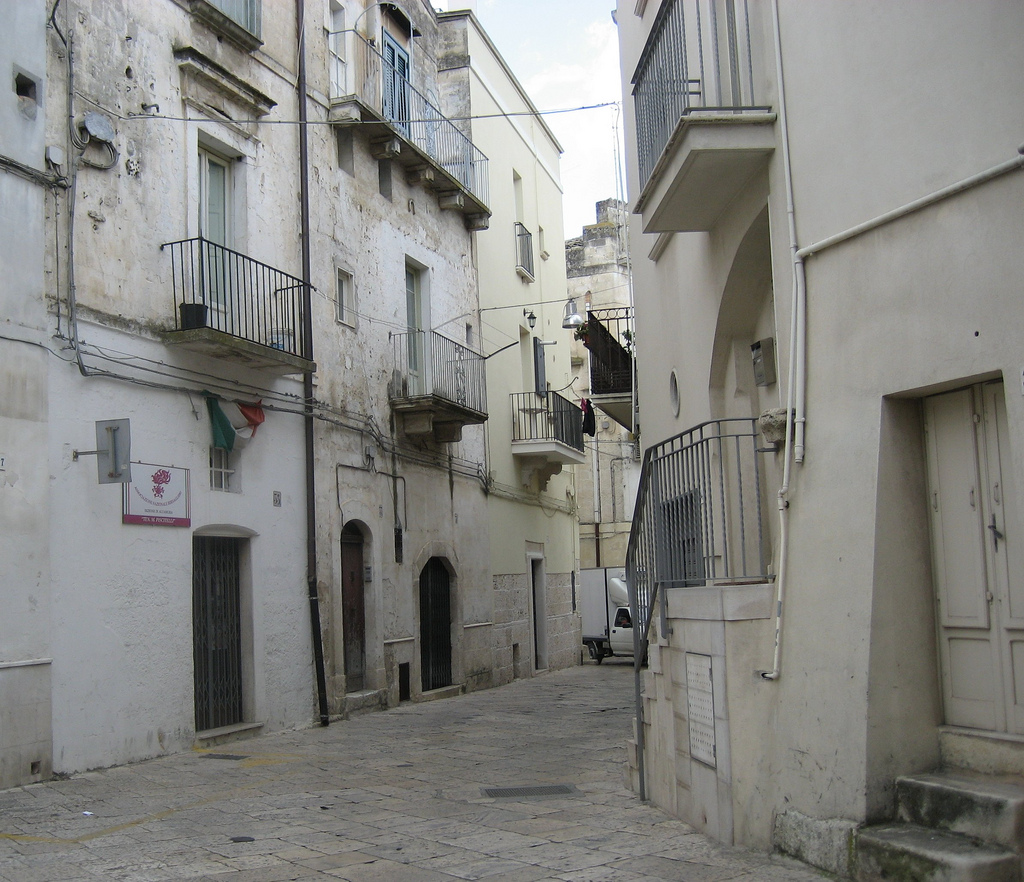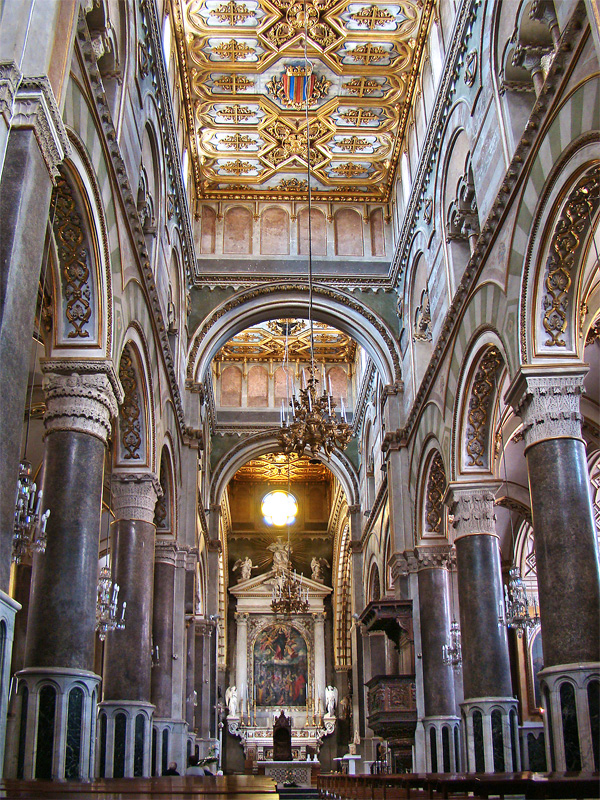|
Altamura Diocesan Museum Matroneum
Altamura Diocesan Museum Matroneum ( it, Museo Diocesano Matronei Altamura, also MUDIMA) is a museum located inside Altamura Cathedral, whose entrance is on the left side of the church's main entrance. It is located on the second and third floors, in the so-called matroneum of Altamura Cathedral. Among other things, the museum holds statues from the Middle Ages, the XV and XVI centuries. Books, notary letters, reliquaries as well as most of the cultural heritage collected in Altamura Cathedral over the centuries are on exhibition inside the museum. The so-called Murat's cloak is also on exhibition. History The museum opened in 2016, thanks to Msgr. Giovanni Ricchiuti, bishop of the diocese of Altamura-Gravina-Acquaviva delle Fonti. See also * Altamura * Archivio Biblioteca Museo Civico * University of Altamura References Bibliography * External links Official website of Museo Diocesano Matronei Altamura (MUDIMA) {{Authority control 2016 establishments in Italy ... [...More Info...] [...Related Items...] OR: [Wikipedia] [Google] [Baidu] |
Altamura
Altamura (, ; nap, label= Barese, Ialtamùre) is a town and ''comune'' of Apulia, in southern Italy. It is located on one of the hills of the Murge plateau in the Metropolitan City of Bari, southwest of Bari, close to the border with Basilicata. , its population amounts to 70,595 inhabitants. The city is known for its particular quality of bread called Pane di Altamura, which is sold in numerous other Italian cities. The 130,000-year-old calcified Altamura Man was discovered in 1993 in the nearby limestone cave called ''grotta di Lamalunga''. History The area of modern Altamura was densely inhabited in the Bronze Age (La Croce settlement and necropolis). The region contains some fifty tumuli. Between the 6th and the 3rd century BC a massive line of megalithic walls was erected, traces of which are still visible in some areas of the city. Ancient city The city was inhabited until around the tenth century AD. Then it was reportedly looted by Saracens. There are no reliable ... [...More Info...] [...Related Items...] OR: [Wikipedia] [Google] [Baidu] |
Giovanni Ricchiuti
Giovanni Ricchiuti is an Italian archbishop of the Catholic church. On 15 October, he's been appointed as archbishop of the diocese of Altamura-Gravina-Acquaviva delle Fonti. Life Giovanni Ricchiuti was born on 1 August 1948 in Bisceglie, in the Province of Barletta-Andria-Trani. He studied at the middle school of the seminary of Bisceglie and he attended the high school and seminaries in Molfetta. On 9 September 1972, he was ordained as presbyter by archbishop Giuseppe Carata. After the ordainment, he continued to study inside the ''Pontificio Istituto Biblico'', Rome. From 1975 to 1976, he was vice-rector of the Minor Seminary and then he was appointed parochial vicar of the ''parrocchia della Misericordia'', in Bisceglie, where he stayed until 1979; in 1980, he was appointed parish priest, while in February 1994, he left the parish after being appointed rector of the seminary ''Pontificio Seminario Regionale Pugliese Pio XI'', located in Molfetta. On 27 July 2005, Pope Bene ... [...More Info...] [...Related Items...] OR: [Wikipedia] [Google] [Baidu] |
Altamura Cathedral
Altamura Cathedral ( it, Duomo di Altamura, ''Cattedrale di Santa Maria Assunta''), dedicated to the Assumption of the Blessed Virgin Mary, is a Roman Catholic cathedral in the city of Altamura, in the Metropolitan City of Bari, Apulia, in southern Italy. Since 1986 it has been the seat of the Bishop of Altamura-Gravina-Acquaviva delle Fonti, formed in that year. Previously it was the church of the territorial prelature of Altamura (from 1848, Altamura e Acquviva delle Fonti). History The church was built by will of emperor Frederick in 1232-1254. The main gate, the portal, the rose window were all on the opposite side that in today's construction, while the altar was located in the area where the main gate is now. In 1248, under pressure from Frederick, Pope Innocent IV declared Altamura exempt from the jurisdiction of the bishop of Bari, making it a "palatine" church, one of four in Apulia. Historian Domenico Santoro (1688) hypothesized that the church may occupy the ... [...More Info...] [...Related Items...] OR: [Wikipedia] [Google] [Baidu] |
Matroneum
A triforium is an interior gallery, opening onto the tall central space of a building at an upper level. In a church, it opens onto the nave from above the side aisles; it may occur at the level of the clerestory windows, or it may be located as a separate level below the clerestory. Masonry triforia are generally vaulted and separated from the central space by arcades. Early triforia were often wide and spacious, but later ones tend to be shallow, within the thickness of an inner wall, and may be blind arcades not wide enough to walk along. The outer wall of the triforium may itself have windows (glazed or unglazed openings), or it may be solid stone. A narrow triforium may also be called a "blind-storey", and looks like a row of window frames. History ''Triforium'' is derived from the Latin ''tres'', ''tria'' "three", and ''foris'', "door, entrance"; its Greek equivalent is τρίθυρον, which originally referred to a building with three doors. The earliest examples ... [...More Info...] [...Related Items...] OR: [Wikipedia] [Google] [Baidu] |
Middle Ages
In the history of Europe, the Middle Ages or medieval period lasted approximately from the late 5th to the late 15th centuries, similar to the post-classical period of global history. It began with the fall of the Western Roman Empire and transitioned into the Renaissance and the Age of Discovery. The Middle Ages is the middle period of the three traditional divisions of Western history: classical antiquity, the medieval period, and the modern period. The medieval period is itself subdivided into the Early, High, and Late Middle Ages. Population decline, counterurbanisation, the collapse of centralized authority, invasions, and mass migrations of tribes, which had begun in late antiquity, continued into the Early Middle Ages. The large-scale movements of the Migration Period, including various Germanic peoples, formed new kingdoms in what remained of the Western Roman Empire. In the 7th century, North Africa and the Middle East—most recently part of the Eastern Ro ... [...More Info...] [...Related Items...] OR: [Wikipedia] [Google] [Baidu] |
Cultural Heritage
Cultural heritage is the heritage of tangible and intangible heritage assets of a group or society that is inherited from past generations. Not all heritages of past generations are "heritage"; rather, heritage is a product of selection by society. Cultural heritage includes cultural property, tangible culture (such as buildings, monuments, landscapes, books, works of art, and artifacts), intangible heritage, intangible culture (such as folklore, traditions, language, and knowledge), and natural heritage (including culturally significant landscapes, and biodiversity).Ann Marie Sullivan, Cultural Heritage & New Media: A Future for the Past, 15 J. MARSHALL REV. INTELL. PROP. L. 604 (2016) https://repository.jmls.edu/cgi/viewcontent.cgi?article=1392&context=ripl The term is often used in connection with issues relating to the protection of Indigenous intellectual property. The deliberate act of keeping cultural heritage from the present for the future is known as Conservation (cul ... [...More Info...] [...Related Items...] OR: [Wikipedia] [Google] [Baidu] |
Diocese Of Altamura-Gravina-Acquaviva Delle Fonti
The Diocese of Altamura-Gravina-Acquaviva delle Fonti ( la, Dioecesis Altamurensis-Gravinensis-Aquavievensis) is a Roman Catholic diocese in Apulia, southern Italy, created in 1986. In that year, the territorial prelature of Altamura e Acquaviva delle Fonti was united with the diocese of Gravina. The present diocese is a suffragan of the archdiocese of Bari-Bitonto."Diocese of Altamura-Gravina-Acquaviva delle Fonti" '' Catholic-Hierarchy.org''. David M. Cheney. Retrieved September 30, 2016. [...More Info...] [...Related Items...] OR: [Wikipedia] [Google] [Baidu] |
Archivio Biblioteca Museo Civico
The Archivio Biblioteca Museo Civico (also A.B.M.C.) is an organization which mainly serves as library and museum and it is located in Altamura, Italy. The archive and library comprise about 90,000 books, mostly about history and literature, among which are scrolls and books dating back to Middle Ages and the 16th century. A.B.M.C. also includes books from the former city library ''Biblioteca Comunale'', replaced by A.B.M.C. in ca. 1950. The number of books has dramatically increased over the years. The library stores valuable books and archeological finds, such as the cofanetto limosino, the tonograph and both ancient and modern art paintings. It also stores some bone fragments believed to have been from Dante Alighieri's hand. Indro Montanelli also mentioned it in his book ''Dante Alighieri'' (booklet number 4 of series “I Protagonisti”, published and sold in 1993 together with Italian newspaper ''Il Giornale ''il Giornale'' ( en, The Newspaper) is an Italian language d ... [...More Info...] [...Related Items...] OR: [Wikipedia] [Google] [Baidu] |
University Of Altamura
The University of Altamura ( it, Università degli Studi di Altamura) was a former university located in Altamura, Apulia, Kingdom of Naples. It was established in Altamura in 1747 by Charles III of Bourbon, following the idea of the archpriest of Altamura Cathedral Marcello Papiniano Cusani. raucci-2003, pag. 349 It was officially closed in 1812, mainly due to the lack of funds, even though some documents kept inside library ''Archivio capitolare'' in Altamura show that professors continued to teach until 1821. raucci-2003, pag. 360 Based on the statements of notable scholars, such as Bernardo Tanucci and Vitangelo Bisceglia, it can be concluded that the university had an excellent reputation at that time. Because of the university, Tanucci described Altamura as ''Appula Atene'' ("Apulia's Athens"). The subjects taught underwent considerable change over the history of the university. In total, the following subjects were taught: Law, ecclesiastical law, Latin, Ancient Greek, He ... [...More Info...] [...Related Items...] OR: [Wikipedia] [Google] [Baidu] |
2016 Establishments In Italy
Sixteen or 16 may refer to: *16 (number), the natural number following 15 and preceding 17 *one of the years 16 BC, AD 16, 1916, 2016 Films * '' Pathinaaru'' or ''Sixteen'', a 2010 Tamil film * ''Sixteen'' (1943 film), a 1943 Argentine film directed by Carlos Hugo Christensen * ''Sixteen'' (2013 Indian film), a 2013 Hindi film * ''Sixteen'' (2013 British film), a 2013 British film by director Rob Brown Music *The Sixteen, an English choir *16 (band), a sludge metal band * Sixteen (Polish band), a Polish band Albums * ''16'' (Robin album), a 2014 album by Robin * 16 (Madhouse album), a 1987 album by Madhouse * ''Sixteen'' (album), a 1983 album by Stacy Lattisaw *''Sixteen'' , a 2005 album by Shook Ones * ''16'', a 2020 album by Wejdene Songs * "16" (Sneaky Sound System song), 2009 * "Sixteen" (Thomas Rhett song), 2017 * "Sixteen" (Ellie Goulding song), 2019 *"16", by Craig David from ''Following My Intuition'', 2016 *"16", by Green Day from ''39/Smooth'', 1990 *"16", by H ... [...More Info...] [...Related Items...] OR: [Wikipedia] [Google] [Baidu] |
Museums In Altamura
A museum ( ; plural museums or, rarely, musea) is a building or institution that cares for and displays a collection of artifacts and other objects of artistic, cultural, historical, or scientific importance. Many public museums make these items available for public viewing through exhibits that may be permanent or temporary. The largest museums are located in major cities throughout the world, while thousands of local museums exist in smaller cities, towns, and rural areas. Museums have varying aims, ranging from the conservation and documentation of their collection, serving researchers and specialists, to catering to the general public. The goal of serving researchers is not only scientific, but intended to serve the general public. There are many types of museums, including art museums, natural history museums, science museums, war museums, and children's museums. According to the International Council of Museums (ICOM), there are more than 55,000 museums in 202 co ... [...More Info...] [...Related Items...] OR: [Wikipedia] [Google] [Baidu] |




